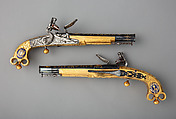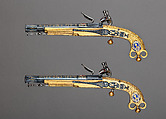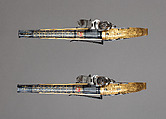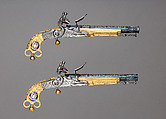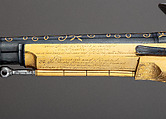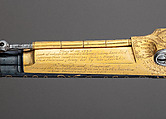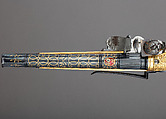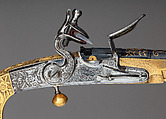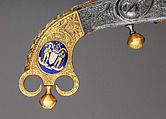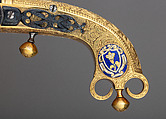Returned to lender The Met accepts temporary loans of art both for short-term exhibitions and for long-term display in its galleries.
Pair of Flintlock Pistols of Scottish Type Presented to Jeffrey, 1st Baron Amherst (1717–1797)
Gunsmith John Murdoch Scottish
Not on view
These pistols rank among the most elaborate and colorful Scottish-style firearms ever produced. While they conform to the traditional Highland type popular during the second half of the eighteenth century, characterized by all-metal stocks with scrolled ‘rams horn’ butts, ball triggers, and belt hooks, their materials and ornament are exceptional. Unlike the customary iron stocks engraved with Celtic interlace, the pistols are fitted with stocks of gilt copper alloy engraved with patriotic imagery that includes an English lion surmounted by a royal crown (on the back of the grips), another lion trampling the Gallic rooster, symbol of France (on the underside of the stocks), and on each face of the grip oval panels enameled with the arms of Amherst and the royal Badge of Scotland. The barrels too follow the distinctive Scottish type, forged with fluted, round, and octagonal sections, but here the surfaces are deeply blued, inlaid in gold with interlace and foliate ornament, and inset at the breech with an oval enamel painted with a sunflower beneath a sun, apparently a personal badge.
These colorful and superbly crafted arms belong to a small group of nearly identical Scottish-style pistols presented to some of Britain’s leading military heroes in the late eighteenth century. Other examples include those made for General Sir Henry Clinton and William Henry, Duke of Clarence. All are fitted with locks by the renowned Scottish gunmaker John Murdoch of Doune, but their barrels are struck with London proof marks, suggesting that the pistols were finished and proved there. The sophisticated engraving and enamels, which invariably bear the arms or emblems of the recipients, may well have been added by London craftsmen. This pair is unusual in having engraved on the stock beneath the barrels a lengthy presentation inscription to Jeffrey, Baron Amherst (1717–1797) by the officers of his Highland regiment: "This Piece of Armor inscribed and humbly presented as a lasting Testimony of Faithful Attachment of Veneration and of Gratitude To the Right Honourable Lord Amherst for his availing Protection to a Corps of Officers appointed to a Regiment of Highlanders Raised in 1775 most of whom had served & many of whom have bled serving their most Gracious King and Country In a Victorious Army led by his Lordship To Success & Conquest During the Last Glorious Was in North America which terminated in 1763." The Regiment of Highlanders referred to in the inscription is probably the 71st Foot (Frasers Highlanders) raised in 1775 and disbanded 1783.
A professional soldier his entire life, Amherst was commander-in-chief of British forces in North America in 1758–63, when he conquered the French territories in Canada and upper New England. He was raised to the peerage in 1776 and twice appointed commander of the British army. In American history Baron Amherst is infamous for supporting plans to eradicate Indigenous settlements by giving their inhabitants blankets infected with smallpox.
Due to rights restrictions, this image cannot be enlarged, viewed at full screen, or downloaded.
This artwork is meant to be viewed from right to left. Scroll left to view more.
